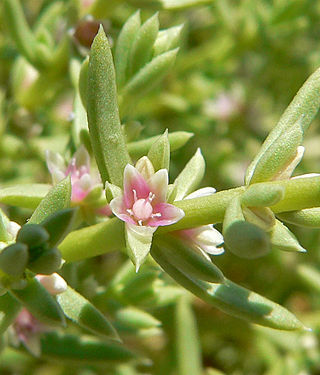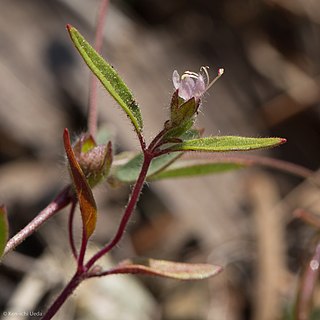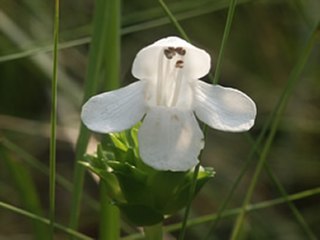Scutellaria barbata, the barbed skullcap, is a species of flowering plant in the mint family, Lamiaceae. It is native to Asia.

Scutellaria galericulata, the common skullcap, marsh skullcap or hooded skullcap, is a hardy perennial herb native to northern areas of the Northern Hemisphere, including Europe, Asia, and almost all of Canada. It is a member of the mint family. The form is upright and is usually 20-45 centimeters in height, sometimes reaching up to 80 cm. It is a wetland-loving species and grows along fens and shorelines. The blue flowers are 1 to 2 centimeters long. The flowers are in pairs and are all on the same side of the stem. The flowers do not appear at the top of the stem.

Leptosiphon ciliatus is a species of flowering plant in the phlox family known by the common name whiskerbrush.

Acmispon maritimus, synonym Lotus salsuginosus, is a species of legume native to Arizona, California and northwestern Mexico. It is known by the common name coastal bird's-foot trefoil. It grows in many types of mountain, desert, and scrub habitat, not necessarily near the coast. It is an annual herb quite variable in morphology, from petite to bushy, hairless to roughly hairy, and prostrate to erect in form. The slender stems are lined with leaves each made up of pairs of leaflets variable in shape and size. The inflorescence is a small array of 1 to 4 yellow flowers, each up to a centimeter long or so. The elongated flower corolla emerges from a tubular calyx of sepals. The fruit is a legume pod up to 3 centimeters long. Laboratory studies have shown this species, which occurs in wildfire-prone habitat such as chaparral, to have an increased rate of seed germination after exposure to heat.

Lycopus asper is a species of flowering plant in the mint family known by the common name rough bugleweed. It is native to much of North America, where it can be found most often in moist areas, such as the soil near lakes. This is a perennial herb growing from a rhizome with thick, knobby tips. The plant grows erect to around 80 centimeters in maximum height, but is known to reach one meter. Its stem is lined with pairs of toothed leaves with heads of flowers in their axils. The flower is white and a few millimeters in length.

Lycopus uniflorus is a species of flowering plant in the mint family known by the common name northern bugleweed. It is native to much of North America and east Asia

Marina parryi is a species of flowering plant in the legume family known by the common name Parry's false prairie-clover. It is native to the deserts of the southwestern United States and northern Mexico. This is a perennial herb producing stiff, branching stems 20 to 80 centimeters long. It is coated with glands and rough hairs. The leaves are made up of several pairs of small oval leaflets no more than 6 millimeters long. The inflorescence is a raceme of deep blue and white bicolored flowers each under a centimeter long. The fruit is a legume pod containing a single seed.
Erythranthe latidens, synonym Mimulus latidens, is a species of monkeyflower known by the common name broadtooth monkeyflower.

Monardella breweri is a species of flowering plant in the mint family known by the common name Brewer's monardella.
Monardella sheltonii is a species of flowering plant in the mint family known by the common name Shelton's monardella.

Monardella viridis is an uncommon species of flowering plant in the mint family which is endemic to California.

Nitrophila occidentalis is a species of flowering plant in the family Amaranthaceae known by the common name boraxweed and sometimes western niterwort. It is native to the western United States and northern Mexico, where it can be found in habitat with moist alkaline soils, such as salt pans. It is a rhizomatous perennial herb producing decumbent or erect stems up to about 30 centimeters tall. The stems have paired branches lined with oppositely arranged, fleshy, linear or oblong green leaves up to 1.6 centimeters in length. Flowers occur in the leaf axils, alone or in clusters of up to 3, accompanied by small bracts. The flower lacks petals but has five pointed sepals 1 or 2 millimeters long which are white or pink in color, fading white with age.

Pycnanthemum californicum is a species of flowering plant in the mint family known by the common name Sierra mint, mountain mint, and California mint.

Frasera albomarginata is a species of flowering plant in the gentian family known by the common name desert green gentian, or desert frasera.
Trichostema laxum is a species of flowering plant in the mint family, known by the common name turpentine weed from the foliage's scent.
Trichostema oblongum, known by the common names oblong bluecurls and mountain bluecurls, is a species of flowering plant in the mint family.

Trichostema ovatum is an uncommon species of flowering plant in the mint family known by the common name San Joaquin bluecurls.

Trichostema simulatum is a species of flowering plant in the mint family known by the common name Siskiyou bluecurls.
Verbena menthifolia is a species of verbena known by the common name mint-leaved vervain or mint vervain. It is native to the southwestern United States and northern Mexico, where it occurs in many types of open, dry habitat such as desert scrub. This perennial herb produces one or more rough-haired, erect stems up to about 75 centimeters in maximum height. The hairy leaves are a few centimeters long and are divided near the base into a few narrow lobes which have serrated edges. The inflorescence is made up of one to three narrow, erect spikes of flowers up to 30 centimeters long. The flowers are spaced, not densely packed on the slender spike. Each flower has a small purple corolla 2 or 3 millimeters wide.

Macbridea alba is a rare species of flowering plant in the mint family known by the common name white birds-in-a-nest. It is endemic to Florida in the United States, where it is found in four counties in the Florida Panhandle. It is threatened by the loss and degradation of its habitat, and it is federally listed as a threatened species of the United States.














